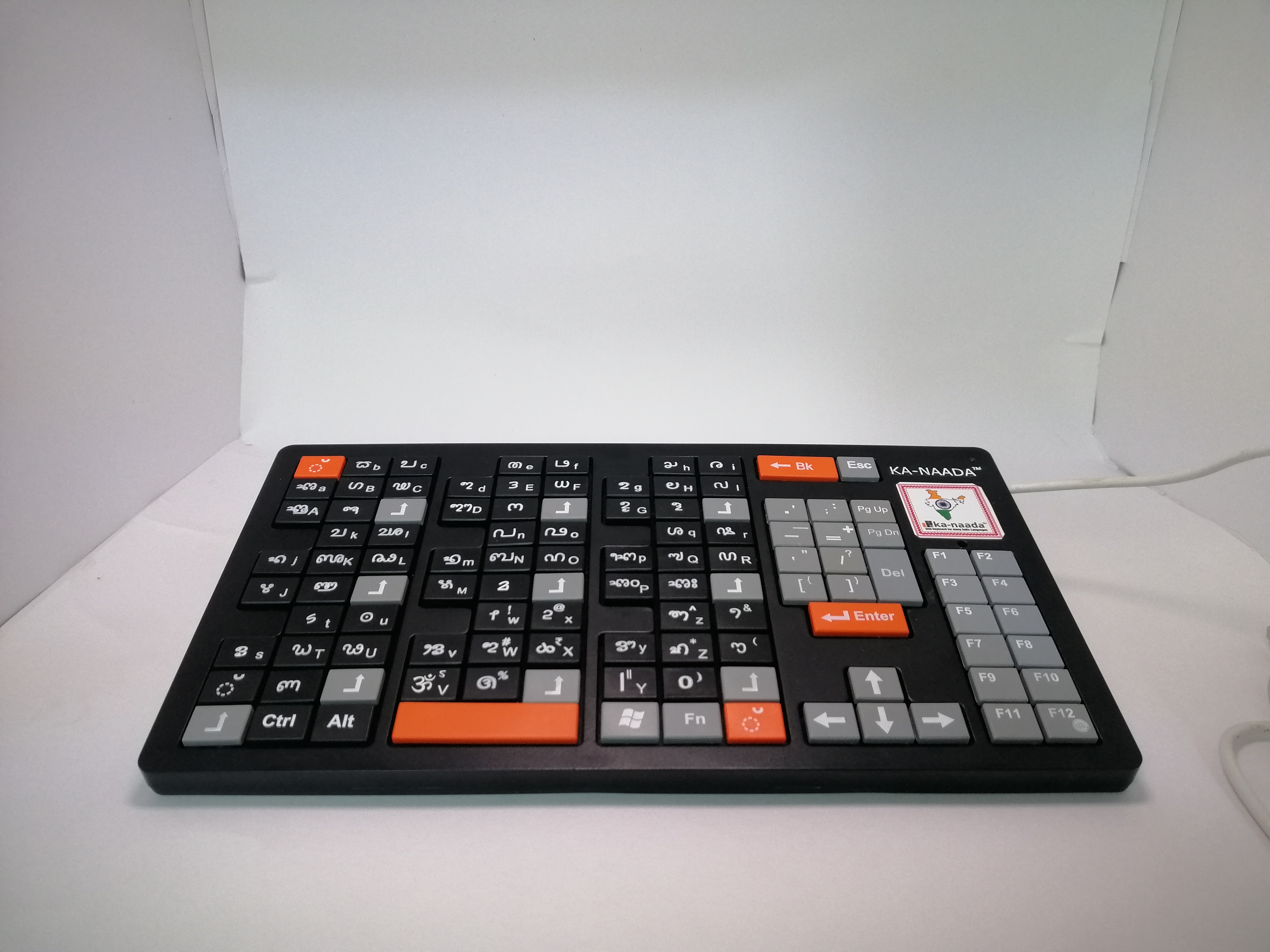
Ka-Nada : A Device for pure Native Approach to Indic Indigenous computing in National and State languages of India
The applications of Ka-Nada can be seen in many areas by an extension of the leads and pointers made below. The Indic language solutions can be of interest to a wide range of national literacy mission addressing the school going multilingual youngsters or National Manuscript mission which supports high end language researchers. The departments of Governance, Central Institute of Indian languages, Technology development of Indian languages (TDIL) would also find this hardware to be a English accommodative hardware to facilitate further the digital language initiative for India.
Job creation through SKILL DEVELOPMENT in INDIGENOUS LANGUAGE DATA ENTRY is a big area where employable skills, education skills, socio-cultural skills, and many things come in. The platform is still one hardware .
Example Curriculum
- Introductions
- Kannada Keyboard Layout
- Download Kannada Typing Tutor Desktop App -Windows
- Kannada Keyboard Finger Mapping Quick Guide
- About Kannada Typing Tutorial (17:01)
- Ka-Naada- Absolute Beginner
- Kannada To English Key mapping Memory1 (17:11)
- Kannada To English Key mapping Memory2 (5:49)
- Kannada To English Key mapping Memory3 (3:24)
- Kannada To English Key mapping Memory4 (3:01)
- Kannada To English Key mapping Memory5 (2:40)
- Ka-Naada- Absolute Beginner -Ver2 -1.2
- Ka-Naada- Absolute Beginner -Ver2 -1.3
- Ka-Naada- Absollute Beginner -Ver2 -1.4
- Ka-Naada- Absollute Beginner -Ver2 -1.5
- Day1
- Day2
- Day3
- Day4
- Day5
- Day6
- Day7
- Day8
- Day9
- Day10
- Day11
- Day12
- Ka-Naada WorkBook-1
- Terms for practice-02 July 2019
- Master File-Kannada_V1
A. Ka-Nada Features
· Ka-Nada is a Hardware Keypad, which translates keystrokes to Unicode compliant signals of selected Indic language characters, for input to Unicode compliant digital devices and applications.
· Ka-Nada is a USB Connect wired hardware layout, which carries a Non-QWERTY layout for ten Indic languages. (* Non-wired version of Ka-Nada is under development.)
· Ka-Nada layout provides Indic language optimized arrangement of Swara-Vyanjana (Vowel- Consonant) clusters to facilitate conjunct and agglutinating letters formation, for brahmi indic language vocabulary, in a naturally phonetic, language appropriate mode.
· Ka-Nada is a Non-English/ Non Roman alphabet character set layout which accommodates English language characters in a model comparable to DVORAK arrangement.
· Ka-Nada is multilingual accommodative for Brahmi phonetic Indian languages model Human Machine Interface hardware.
· Ka-Nada allows direct keying in of Brahmi indic language characters without recourse to intermediate overlay mapping of roman alphabet characters, to Unicode compliant digital devices, applications and interfaces.
· Ka-Nada does not use overlay stickers and skins in switching across brahmi indic languages or english to indic.
· Ka-Nada promotes keying in of key sequence combinations to generate phonetic script appropriate flow of language characters by 'True Natural phonetic by Language- phoneme sequence'. This overcomes the limitation faced by indian language typists using current model of indic language software solutions forcing them to type letters "graphically" instead of language phonetically; which involves a mental operational step to ' make spelling conversion to key in from brahmi word to roman alphabet sequence by spelling and phonemes, and then proof the output.
· Ka-Nada will serve as a platform to address the challenges of ' Brahmi character rendering properly' to better facilitate ' Unicode Search by Indic language script specificity' and ' address the technical challenge of 'graphical decomposition of Indian language characters in rendering and screen display'. The necessary guidelines are already provided in the Unicode encoding deliberations of canonical ordering.
· Ka-Nada can help further development in Tamil Grantha, which is not currently included Unicode, but can be encoded in parallel with Tamil. However, a separate encoding seems to be in the making already . Similarly for Ka-Nada can help in proper encoding of Tulu distinctly from Malayalam.
· Ka-Nada, as a 'one portable and add-on keyboard for national and state languages of India' using a common base USB- connectivity path and work with QWERTY keyboards of existing hardware (desktop and laptops) as a supplement, for digital data creation in national and state languages of India along with English, can help in speeding up the Government of India initiative of the National e-Governance Plan, with the intent to support the growth of e-Governance within the country. The Plan envisages creation of right environment to implement G2G, G2B, G2E and G2C services. The lack of availability of information in the locally understandable language is the main reason for the slow progress in the Information and Communication Technology (ICT) sector. In today’s age, access to ICT plays a major role in the overall development of a country, it has become a challenge to bridge the digital divide caused by the language barrier. Indic language appropriate Native Keyboard without overtones of English characters, and yet work well with the existing hardware infrastructure helps to develop Language- Standardization in Governance through better in localization. Standardization means to follow certain universally accepted standards, so that the developers from any part of the globe could interact through the application. Standardization becomes applicable in almost everything specific to the language – for instance, a standard glossary of terms for translation, a standard keyboard layout for input system, a standard collation sequence order for sorting, a standard font etc.
· Ka-Nada addresses the Hardware part critically needed to implement the Unicode Character Encoding standard for all constitutionally recognized Indian Languages and promote Unicode compliant global data interchange. This will help to improve the e-Government Services providers in all constitutionally recognized Indian Languages from Government to Citizens. This will be augmenting the efforts of TDIL (Technology for Indian Languages) and DIT (development of Indian Technologies). Unicode encoding is available at OS level. Ka-Nada supports the implementation of it through the Hardware - interface level.

Hindi Keyboard

Kannada Keyboard

Tulu Keyboard
Example Featured Products
Showcase other available courses and coaching products you’re selling with the Featured Products block to provide alternatives to visitors who may not be interested in this specific course.

